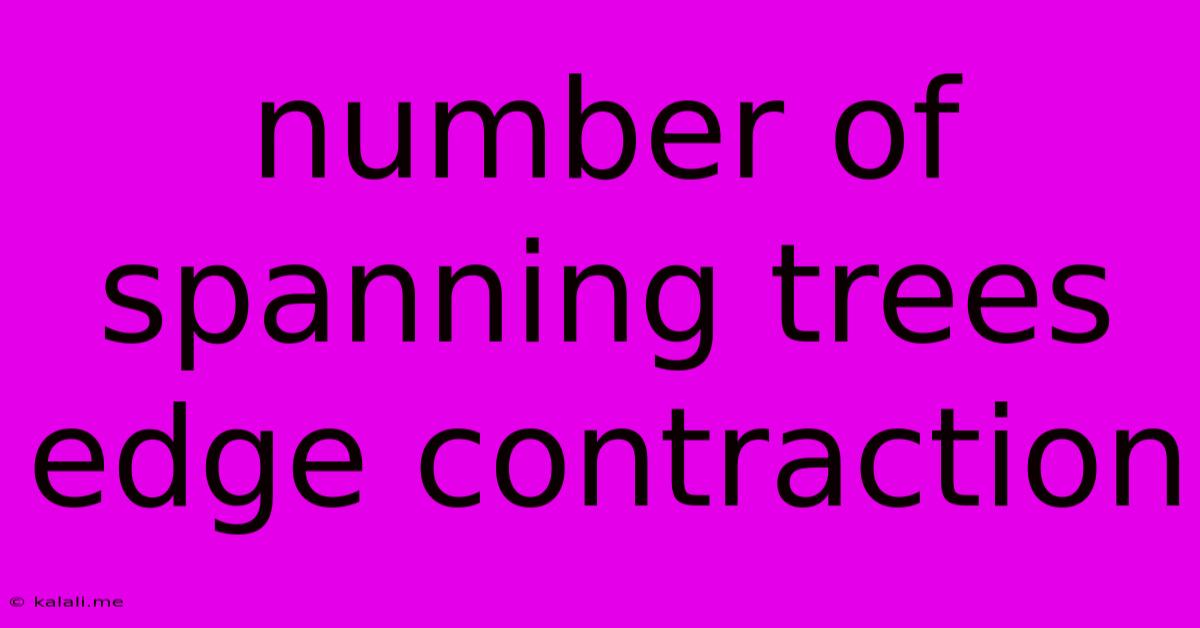Number Of Spanning Trees Edge Contraction
Kalali
May 23, 2025 · 3 min read

Table of Contents
Counting Spanning Trees Using Edge Contraction: A Comprehensive Guide
Meta Description: Learn how to efficiently count the number of spanning trees in a graph using the matrix-tree theorem and the edge contraction method. This guide provides a clear explanation with examples and practical applications.
Counting the number of spanning trees in a graph is a fundamental problem in graph theory with applications in network reliability, electrical network analysis, and other fields. While the matrix-tree theorem provides a powerful algebraic method, the edge contraction method offers a more intuitive and sometimes computationally advantageous approach, especially for smaller graphs. This article will delve into the edge contraction method, explaining its principles and illustrating its application through examples.
Understanding Spanning Trees
Before diving into the edge contraction method, let's clarify what a spanning tree is. A spanning tree of a connected graph G is a subgraph that is a tree (contains no cycles) and includes all the vertices of G. Essentially, it's a way to connect all vertices with the minimum number of edges while avoiding cycles.
Finding one spanning tree is relatively straightforward. However, determining the total number of spanning trees becomes significantly more complex as the graph size increases. This is where methods like edge contraction prove valuable.
The Edge Contraction Method: A Step-by-Step Guide
The core idea behind the edge contraction method is to iteratively reduce the graph's size by contracting edges. Contracting an edge means merging its two endpoints into a single vertex, removing self-loops that might be formed in the process. Crucially, this process preserves the number of spanning trees.
Here's a step-by-step breakdown:
-
Choose an edge: Select any edge in the graph.
-
Contract the edge: Merge the two vertices connected by the chosen edge into a single vertex. Remove the contracted edge and any self-loops or parallel edges created by the contraction.
-
Repeat: Continue steps 1 and 2 until only one vertex remains. The number of ways to reach this final state corresponds to the number of spanning trees in the original graph. Each sequence of edge contractions represents a unique spanning tree.
-
Account for multiple edges: If, during contraction, parallel edges are created, treat them as distinct edges.
Illustrative Example
Let's consider a simple complete graph K₃ (a triangle). We'll use the edge contraction method to count its spanning trees:
-
Start with K₃: Three vertices, three edges.
-
Contract an edge: Choose any edge and contract it. This leaves a single edge and a single vertex (the merged vertices), resulting in one spanning tree from this contraction sequence.
-
Repeat with different edges: Since there are three edges, there are three possible starting edges. Each will eventually lead to the same single-vertex outcome, corresponding to one spanning tree.
-
Total spanning trees: Therefore, K₃ has three spanning trees.
More Complex Examples and Considerations
For larger and more complex graphs, the number of possible contraction sequences grows rapidly. This method becomes computationally expensive for very large graphs. For these scenarios, the matrix-tree theorem is generally more efficient. However, for smaller graphs or those with specific structures, edge contraction can provide a clear and insightful approach.
The edge contraction method, while intuitive, can become cumbersome for larger graphs. It's crucial to organize the contraction sequences systematically to avoid counting the same spanning tree multiple times. Techniques like creating a decision tree can improve the organization and reduce the risk of errors.
Conclusion
The edge contraction method offers a valuable, intuitive alternative to the matrix-tree theorem for counting spanning trees, particularly in smaller graphs. While its computational complexity increases rapidly with graph size, understanding this method provides a deeper understanding of spanning trees and their properties. By carefully applying the steps and systematically tracking the contraction sequences, one can effectively determine the number of spanning trees in a graph using this technique. Remember to consider potential parallel edges generated during the contraction process.
Latest Posts
Latest Posts
-
Car Does Not Make Any Sound When Trying To Start
May 23, 2025
-
Test For Broken Symbolic Link Perl
May 23, 2025
-
Gravitational Pull Of A Black Hole
May 23, 2025
-
How To I Access Grub On Windows
May 23, 2025
-
What Does It Mean If The Groundhog Sees His Shadow
May 23, 2025
Related Post
Thank you for visiting our website which covers about Number Of Spanning Trees Edge Contraction . We hope the information provided has been useful to you. Feel free to contact us if you have any questions or need further assistance. See you next time and don't miss to bookmark.